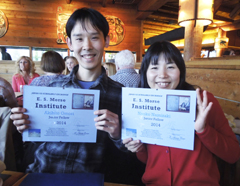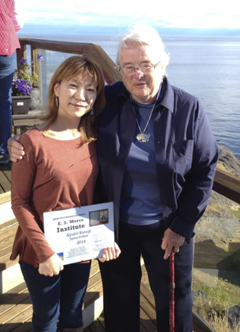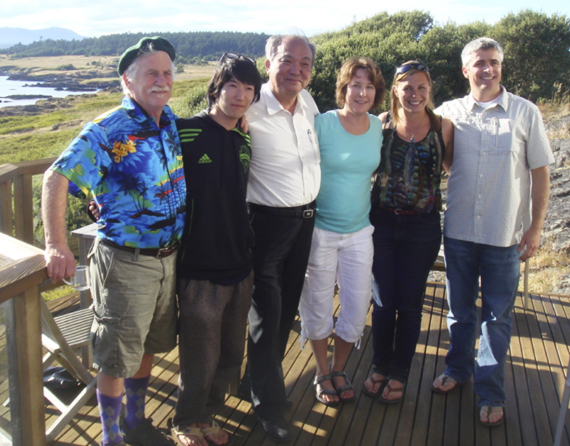The Edward Sylvester Morse Institute: an Update
Trish Morse
 Figure 1. Akihito Omori and Naoko Namizaki receiving their certificates as Junior Scholars in the E. S. Morse Institute. Photo credit: G. Lambert.
Figure 1. Akihito Omori and Naoko Namizaki receiving their certificates as Junior Scholars in the E. S. Morse Institute. Photo credit: G. Lambert.
Scholar exchanges between the U.S.A. and Japan continue. In April, two scholars joined us at Friday Harbor Labs from the University of Tokyo: Naoko Namizaki, Project Researcher from the Research Center for Marine Education, and Dr. Akihito Omori, Assistant Professor. Both are researchers at the Misaki Marine Laboratory (Fig. 1). Naoko worked with Jenny Roberts and Kari Koski (Friday Harbor Labs K-12 Science Outreach Program) visiting the Friday Harbor High School and Spring Street International School classrooms, along with meeting biology educators at the Whale Museum, Burke Museum, and Seattle Aquarium. Both Naoko and Akihito were inducted into the E. S. Morse Institute as Junior Scholars, and Akihito shares his experiences below.
From Dr. Akihito Omori:
I greatly appreciate the E. S. Morse institute for giving me such a wonderful opportunity to visit Friday Harbor Labs (FHL). My point to visit Friday Harbor was to do some experiments for my own work, and to observe and take pictures of the animals on the North West U.S. coast for my first teaching of the biodiversity course at Misaki Marine Biological Station (MMBS). With the kind help of Dr. Trish Morse and Dr. Petra Ditsche, I did my experiment successfully in that short stay. The animals at San Juan Island were highly impressive, especially in their huge size and strange shapes. The fieldwork with Dr. Tom Mumford, which was part of the spring quarter at FHL, also gave me great information about animals and algae around San Juan Island, and I got some ideas for the course at MMBS. It was also a great experience to give a talk at FHL seminar, which was kindly set for me by Prof. Billie Swalla and Dr. Nicholas Gidmark, and have some wonderful activities with Ms. Lauren Vandepas and Mr. Michael Tassia, who are also junior fellows of E. S. Morse institute. This kind of opportunity to visit foreign labs, have a variety of experiences, and communicate with foreign researchers is precious for Japanese researchers and students. It would be nice if more researchers and students are encouraged to apply for the Japan/U.S. scholar exchange program. I hope this community of Japan and U.S. researchers and students becomes larger and more active.
**********************************************************
 Figure 2. Ayako Katayi with Trish Morse at the picnic receiving her certificate as a Junior Scholar in the E. S. Morse Institute. Photo credit: L. Vanderpas.
Figure 2. Ayako Katayi with Trish Morse at the picnic receiving her certificate as a Junior Scholar in the E. S. Morse Institute. Photo credit: L. Vanderpas.
This summer a former FHL course graduate, Ayako Katayi (known to us as Ya Ya), returned to carry out research on invertebrate embryology in Director Billie Swalla’s laboratory. A picnic was held to induct her into the E. S. Morse Institute (Fig. 2), and a number of Morse Scholars including our recent scholars Michael Tassia and Lauren Vanderpas were able to join in the celebration.
Morse Institute members have been actively involved in research funded by a grant from the U. S. Department of Agriculture to Dr. Vera Trainer (NOAA and member of the Morse Institute Committee) along with Marco Hatch (Northwest Indian College - NWIC), Sandy Wyllie-Echeverria (FHL), and Ichiro Imai (Hokkaido University). They are doing work on the interaction of algicidal bacteria associated with seagrasses and species that cause harmful algal blooms (Fig. 3). Nobuharu Inaba (Morse Institute Scholar - MIS 2012) trained NWIC students on bacterial isolation techniques from natural samples during spring 2014. He and Professor Ichiro Imai (MIS 2012) visited FHL for a meeting of the project investigators, and Professor Imai gave a seminar at NOAA and at the Labs.

Generous support from the Mikimoto Foundation Grant to the Misaki Marine Biology Laboratory (University of Tokyo) and from the FHL E. S. Morse Institute Fund provided some of the funding for these visitors and we want to thank the benefactors for these contributions to this wonderful international program.



